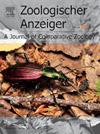Monogamy and sexual dimorphism: Evaluation of the morphometric relationship of body and secondary sexual structures in heterosexual pairs of Alpheus estuariensis Christoffersen, 1984
IF 1.5
3区 生物学
Q2 ZOOLOGY
引用次数: 0
Abstract
Sexual monomorphism or reduced sexual dimorphism in the body or cheliped size is expected in caridean shrimps that exhibit a monogamous mating system. In contrast to the mating system models proposed in crustaceans, monogamous heterosexual pairs of same Alpheus species exhibit sexual dimorphism. This raises questions about how sexual selection acts in these shrimps. We hypothesized that secondary sexual structures, but not the body, exhibit a tendency for size and directional allometry in each sex. We evaluate sexual size dimorphism in heterosexual pairs of Alpheus estuariensis, and the morphometric relationship of the body, and secondary sexual structures (cheliped and second pleonal segment), in heterosexual pairs of three populations. Carapace length did not differ between males and females, exhibiting a positive size correlation among monogamous pairs, indicating size-assortative mating across the three locations. Males bear larger cheliped propodus, while females had larger second pleura, indicating sexual size dimorphism. The propodus relationship between the sexes displayed positive allometry in the Paraíba do Norte River, whereas heterosexual pairs from the Paripe River and Massangana River showed isometry in cheliped propodus size between sexes. Furthermore, heterosexual pairs demonstrated negative allometry for pleura width. These findings support the hypothesis that secondary sexual structures, but not the body, exhibit size and directional allometry. We believe that these results are linked to the reproductive success of each sex in A. estuariensis. This implies that even within a monogamous mating system, selective sexual pressures play a role in the sexual dimorphism in these shrimps.
一夫一妻制与两性二态性:异性恋的Alpheus estuariensis Christoffersen, 1984
在表现出一夫一妻制的交配系统的caridean虾中,预计在身体或鳍大小上的性单态或减少性二态。与在甲壳类动物中提出的交配系统模型相反,同一种Alpheus的一夫一妻制异性伴侣表现出两性二态性。这就提出了关于这些虾的性选择是如何起作用的问题。我们假设第二性结构,而不是身体,在两性中表现出大小和方向异速的倾向。我们评估了三种异性恋阿尔菲斯河口的两性大小二态性,以及身体和第二性结构(足跖和第二胸骨节)的形态测量关系。甲壳长度在雄性和雌性之间没有差异,在一夫一妻制的配对中表现出正的尺寸相关性,表明三个地点的尺寸选型交配。雄性有较大的足跖,而雌性有较大的第二胸膜,表明两性大小二态性。在Paraíba do Norte河中,两性之间的似足动物关系表现出正异速,而来自Paripe河和Massangana河的异性恋配对在有足动物大小上表现出两性之间的等距。此外,异性恋伴侣胸膜宽度呈负异速测量。这些发现支持了一个假设,即第二性结构,而不是身体,表现出大小和方向异速。我们认为这些结果与河口拟南蝽两性的繁殖成功有关。这表明,即使在一夫一妻制的交配系统中,选择性的性压力在这些虾的两性二态性中也起着作用。
本文章由计算机程序翻译,如有差异,请以英文原文为准。
求助全文
约1分钟内获得全文
求助全文
来源期刊

Zoologischer Anzeiger
生物-动物学
CiteScore
2.80
自引率
7.10%
发文量
75
审稿时长
>12 weeks
期刊介绍:
Zoologischer Anzeiger - A Journal of Comparative Zoology is devoted to comparative zoology with a special emphasis on morphology, systematics, biogeography, and evolutionary biology targeting all metazoans, both modern and extinct. We also consider taxonomic submissions addressing a broader systematic and/or evolutionary context. The overall aim of the journal is to contribute to our understanding of the organismic world from an evolutionary perspective.
The journal Zoologischer Anzeiger invites suggestions for special issues. Interested parties may contact one of the editors.
 求助内容:
求助内容: 应助结果提醒方式:
应助结果提醒方式:


